
At the end of last week, the Federal Reserve held its annual “Jackson Hole Economic Symposium,” a three-day conference hosted by the Federal Reserve Bank of Kansas City.
The conference is attended by central banker leaders, academics, financial industry leaders, journalists, and government officials to discuss world events and financial trends and potentially provide insights on the direction of interest rates. The symposium is held at the Jackson Lake Lodge in Grand Teton National Park in Jackson, Wyoming.

I had the pleasure of spending a few days in Jackson and Grand Teton National Park (GTNP) in July. It was one of the most picturesque places I have ever enjoyed visiting. My wife and I spent one morning on a leisurely raft ride on the Snake River through GTNP, soaking in the wildlife and the scenery of the Tetons. During that ride, our view was of beauty and optimism. We were in awe of everything around us. I am not sure if the view of the economy for the members of the Federal Reserve matched the view of the backdrop of their meeting. However, Fed Chairman Jay Powell’s remarks near the end of the meeting set off optimism like ours. In the remainder of today’s column, I will discuss Chairman Powell’s remarks and comment on whether they provide a beautiful view of the future economy and whether the optimism of financial markets is warranted.
Following Chairman Powell’s remarks on Friday morning, U.S. equity markets surged, with the Dow Jones Industrial Average reaching a record high and other indices rising sharply. In addition, bond prices rallied as their yields fell (Note: Bond prices and yields move in opposite directions. As yields go down, the cost of bonds that have higher yields go up). The reason that both equities and bond prices surged was the prospect of lower interest rates. In Powell’s remarks, he suggested that the Fed might be open to cutting interest rates, a move away from the current restrictive monetary policy. Equity markets clearly saw this as a good sign, and we can be sure President Trump is encouraged as well. Most Fed observers are predicting a 25-basis-point (one-quarter percent) rate decrease at the Fed’s next meeting on September 16-17. However, while many are optimistic about such a cut occurring, maybe we should not be so happy as to why.
As a quick review for you (and President Trump!), the Federal Reserve (“the Fed”), which is the central bank of the U.S., conducts our country’s monetary policy. The Fed has a statutory monetary policy “dual mandate,” established in the 1977 amendment to the Federal Reserve Act of 1913. This dual mandate requires the Fed to conduct monetary policy to achieve maximum employment and stable prices. Another way of thinking about achieving stable prices is keeping inflation in check. Clearly, when inflation is high, prices are not stable. The Fed has judged that a 2% inflation rate over the long run is most consistent with its goal of stable prices.

With this in mind, let us see why Chairman Powell is now more open to decreasing rates at the coming Fed meeting in September and beyond.
Chairman Powell and most other members of the Federal Open Market Committee (FOMC), the monetary policymaking body of the Fed, which sets the federal funds rate that drives interest rates, have been reluctant to lower rates in recent months, much to the chagrin of President Trump. The primary motivation for that reluctance is that the inflation rate has remained “sticky” at an annual rate between 2.5% and 3.0%. In addition, the uncertainty of the impact of President Trump’s tariffs on inflation has increased their reluctance. Since higher interest rates are usually effective to keep inflation in check, then why is Powell and the Fed now more open to lowering rates?
Unfortunately, it is not necessarily because of good news. As noted above, the dual mandate for the Fed also includes achieving maximum employment. While news on the employment front had been mostly positive, the labor front has recently shown signs of softening. U.S. job growth slowed to 73,000 jobs in July, well below the expected gain of 100,000. In addition, downward revisions of job growth in May and June were a combined 258,000 jobs, leaving May to having added just 19,000 jobs and June just 14,000. Interest rate reduction is usually a tool to increase job growth to achieve maximum employment, so these recent job market statistics have put interest rate cuts back in play. However, this could be risky if inflation remains high. In the next three weeks, the members of the FOMC will be keeping a close eye on the inflation indices (Consumer Price Index (CPI), Producer Price Index (PPI)) to help determine if inflation is tame enough to lower rates at their September meeting.
Therefore, while Chairman Powell signaled from Jackson Hole that he was now amenable to lowering rates (i.e., less restrictive monetary policy), it was not necessarily a decision made from optimism. Rather, it came from a potential softening of the employment picture and economy as a whole, and a hope that tariffs will not cause more inflation. So, while my visit to Jackson was one of beauty and optimism, the Fed’s visit was one of hope, but also trepidation.






